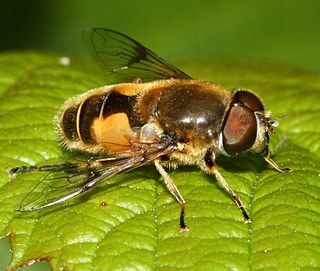
Eristalis is a large genus of hoverflies, family Syrphidae, in the order Diptera. Several species are known as drone flies because they bear a resemblance to honeybee drones.

The subfamily Microdontinae contains slightly more than 400 species of hoverflies and, while diverse, these species share several characteristics by which they differ from other syrphids. The Microdontinae are myrmecophiles, meaning they live in the nests of ants. Larval Microdontinae are scavengers or predators in ant nests, and, in contrast to other syrphid larvae, have no readily apparent body segmentation. Some species also do not exhibit the typical adult flower-visiting behaviour of other hoverflies, but instead remain near their larval host colonies.

Eristalinus is a genus of hoverfly. Most species have very distinctive eye marking in the form of spots or banding, though these features may fade on some preserved specimens. Most are stout flies, and are nimble flyers, even compared to other hoverfly species.

Helophilus are a diverse genus of moderate to large hoverflies, that appear somewhat bee-like. This genus comprises two subgenera: Helophilus and Pilinasica. Larvae filter-feed in organic rich water. All Helophilus adults have a distinctive lengthwise striped thorax and a transverse striped abdomen.

Platycheirus is a large genus of hoverflies. They are also called sedgesitters.
Kertesziomyia is a genus of 14 Hoverflies, from the family Syrphidae, in the order Diptera.
Austalis is a genus of Hoverflies, from the family Syrphidae, in the order Diptera.
Surimyia is a genus of hoverflies, with three known species. They are small microdontine flies. Surimyia is the only hoverfly genus with the katatergum lacking microtrichia. In the subfamily Microdontinae, they are distinctive in the absence of pilosity on the postpronotum.

Eristalini is a tribe of hoverflies. Several species are well-known honeybee mimics, such as the drone fly Eristalis tenax, while other genera such as Helophilus and Parhelophilus exhibit wasp-like patterns of yellow and black stripes, both strategies to avoid predation by visual predators such as birds.
Digulia is a monotypic genus of hoverfly from the family Syrphidae, in the order Diptera. The single species, D. kochi, is found in New Guinea.
Dissoptera is a genus of hoverfly, insects in the family Syrphidae, in the order Diptera. It consists of seven species distributed through the Australasian and Oriental regions.
Lycastrirhyncha is a genus of 5 neotropical flower flies or hoverflies.

Palpada is a genus of 85 neotropical and nearctic flower flies or hoverflies This genus is often colorful and bee-like. It is in the tribe Eristaliini containing dozens of genera Common sister genera include Eristalis (99 species), Meromacrus (43 sp.), Eristalinus (100 sp.) and Helophilus (50 sp.). The genus palpada is distinguished by:

Meromacrus is a genus of 43 neotropical and nearctic flower flies or hoverflies

Phytomia is a genus of at least 27 species of hoverfly from the family Syrphidae, in the order Diptera found in tropical Africa and Asia.
Simoides is a genus of 7 species of Afrotropical hoverfly from the family Syrphidae, in the order Diptera.

Meromacroides is a monotypic genus of Afrotropical hoverfly from the family Syrphidae, in the order Diptera.
Solenaspis is a monotypic genus of hoverfly from the family Syrphidae, in the order Diptera.

Eristalina is a subtribe of hoverflies with 17 genera. Several species are well-known bee mimics, such as the drone fly. The larvae live in aquatic and moist organic material, often with low oxygen levels using a posterior breathing tube, thus the common name—the "rat-tailed maggot".










